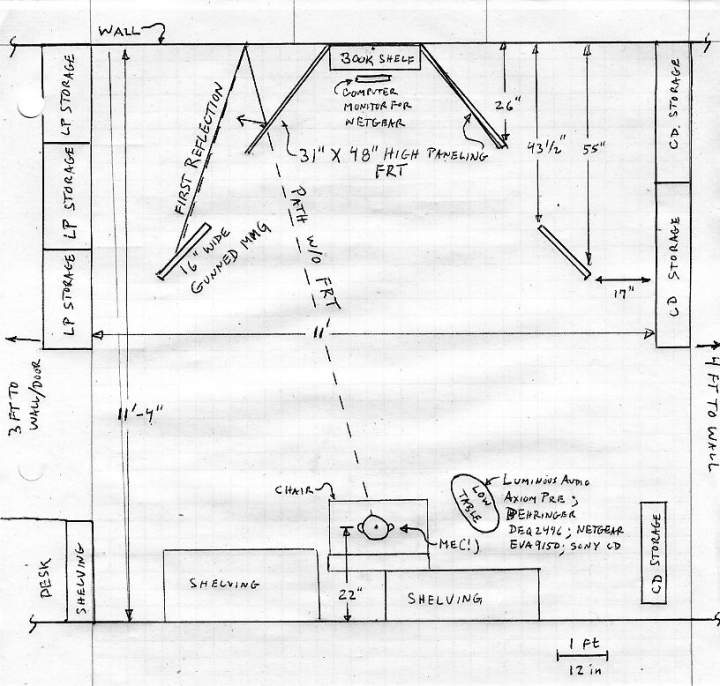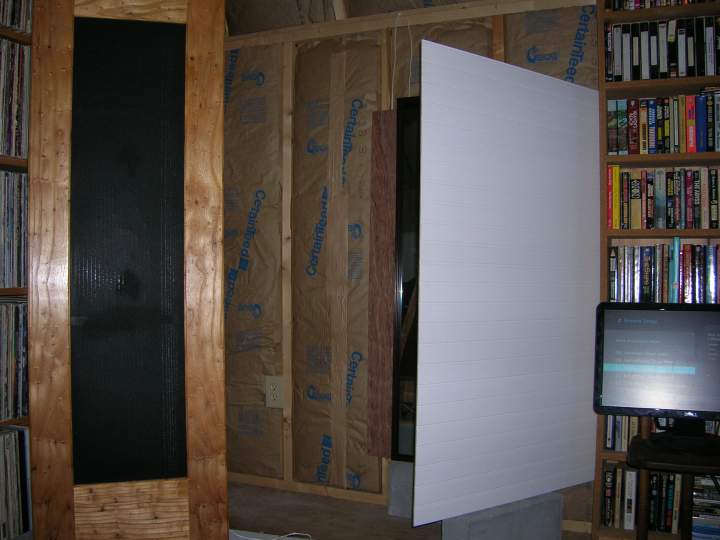Hello and Greetings:
No, I'm not selling anything! This is my first post here, but it is a
follow-up from earlier postings at that Asylum place over there, where I claimed the right to name the idea. It is
a partial cross-post, but since I have some follow-up ideas about this
idea that I figured would be appropriate for this forum, I decided to
make it my initial foray here. Besides, if I say so myself the basic
idea could be really helpful to other Planar owners...
I have my "Gunned" MMGs in a 11 foot by 11 foot "listening room" carved
out of an 11 foot wide by 20 foot long shed, with a barn-like ceiling (8
foot-4 inch average height, peak height 9 foot plus), insulated and
climate controlled. Because it also has to act as storage for several
pieces of furniture and other stuff, I could never make the full
footprint symmetric enough for Maggies to throw a reasonable soundstage.
The non-exterior "walls" consist of my 6 foot tall vinyl LP Album and CD
shelving to make a symmetric listening space within the shed, keeping
spaces on the back sides of the media shelving for storing the most
non-symmetric stuff. The bad news of course is that the listening space
becomes a 11 foot X 11 foot square!
I settled on 3 facts right away: 1) by necessity, this will be nearfield
listening, which the Gunn mod makes really easy to live with due to his
crossover mod; 2) since getting the recommended 10 millisecond delay in
first reflections would be impossible any other way, the listening seat
(LS) would be right up against the shelving along the back wall. Others
have reported no serious problems sitting close to the rear wall, which
I attribute to evolution preparing our ears to deal with rear
reflections. So it should have fewer audio consequences compared to
early reflections off the front or side walls. 3) I also decided that,
in spite of the tipped back nature of the Gunn frames, the MMGs still
sound their best tipped nearly vertical with the drivers centered at ear
level. So they are sitting on concrete cinderblocks with the rear spikes
shimmed to make the panels very nearly vertical with only a slight
backward tilt to get the center lined up to ear level.
Fast forward through many months and MANY attempts with the Rooze, Hong
Kong/Limage, Cardas, Jim Smith's "Get Better Sound", Beveridge (a.k.a.
sideways a.k.a. Stereo Unlimited (Walnut Creek)), Ambiophonics, and
random drunkard's walk placement experiments.

I finally stumbled on
a placement about 50 inches from the front wall and 17 inches from the
side shelves to the outer speaker edge which had fairly even frequency
response properties*. With a 45 degree toe-in so the direct sound
crossed about 2 feet in front of me, there was some real depth to an
amazingly wide soundstage. So far so good, but even with tweeters on the
inside the phantom center sounded like cardboard (how's that for an
audiophile descriptor?) compared to a monophonic signal from one speaker
only. I came to realize that some serious comb filtering due to the
first reflection being only about 7 milliseconds after the direct sound
was the likely culprit.
I suspect this phenomenon is the "gorilla in the room" for many folks
here, especially those with small listening rooms. This business of a
monophonic "phantom center" signal from 2 speakers sounding different
(wooly? Like cardboard? The proper term escapes me) compared to the
sound of one speaker alone seems like an unfortunate consequence of
stereophony, to be put up with unless you "upgrade" to multi-channel
sound. Well, I humbly submit that, at least in my room I beat it with a
$20 USD investment. Perhaps you can too.

The brainstorm: what if you could delay (not absorb or diffuse)
rear-wave reflections from reaching the LS by use of a baffle? I had
some wood paneling pieces around, and I took 2 designed for fake
wainscoting (48 inches wide by 31 inches high), turned them on their
side so they were now 48 inches high by 31 inches long and angled them
out from the front wall into the room in such a way that the first
reflection from the front wall is "trapped" behind the paneling, hence
the name "First Reflection Traps" (FRTs). Not absorbed; the point is to
have the first reflection bounce around the front and sides to lengthen
the time it takes to reach the listening position. I settled on the
position by placing a mirror at the first reflection point, and ensuring
the paneling blocked the speaker from view. Since I had a small (6 inch
deep X 20 inch wide X 6 foot high) bookcase centered on the wall, it
acted as a convenient brace and spacer for the panels. Like the MMGs,
the paneling is also sitting on cinder blocks to elevate them in line
with the MMGs. The result? Spacious sound, by my calculations the first
reflection went from about 7 milliseconds to at least 16 milliseconds
after the direct sound reaches the listening position**. The phantom
center now sounds very nearly identical to the sound of one speaker
alone. And the depth of the soundstage was not harmed; in fact, it may
have improved! Here is the floor plan:

and a photo taken from the LS:

I think the 45 degree angle of the MMGs to the side wall is a key
element to this strategy, because it allows placement near the side wall
(good for bass reinforcement and for getting as wide a stereo soundstage
possible in a narrow room) while keeping the first reflections from
those side walls behind the speaker to bounce to the front wall, where
the FRTs as well as the bulk of the speaker can manage them by
lengthening their arrival time to the LS.
Since a lot of folks place a big TV between Maggies, some of the
positives they provide the sound could be some degree of first
reflection trapping similar to my FRTs. Especially the old-school big
TVs which taper towards a point in back behind the screen. It seems to
follow that, if one uses these FRTs that one could put ANYTHING centered
between them without affecting the sound, as long as it didn't stick out
further from the front wall than the forward edge of the FRT. Also, the
FRT probably shouldn't extend beyond the plane of the Maggies. I could
imagine a variant which even has some WAF, if they are made to look like
attractive, self-standing oriental screens behind the TV perhaps. As
long as the backs of the screens are acoustically reflective, the front
could be anything attractive, like rice paper behind a wood latticework.
Since mine are in a shed which my significant other refuses to enter,
WAF is academic in my case.

OK, what does it sound like? Unfortunately I can't write in Audiophilia
as well as I can read it. All I can say is that music sounds like I'm
sitting in the second row of an intimate theater, with a stereo spread
approaching that of headphones, except for being totally outside the
head vice in-the-head like headphone listening typically is. Drums in
particular sound present in the room, although a lot of that came from
the Gunn mod. The excitement factor is through the roof, and I can
listen for hours without ear fatigue. I also suspect some here would
consider me a heretic for using a Behringer EQ as my DAC. All I can say
is that, judiciously used, it just seems to work without screwing up the
sound, like the Gunn mod does on my MMGs. OK, maybe the EQ function
introduces a little congestion to the sound, but that is more than made
up for by the evenness of the frequency response, meaning ALL the notes
get equal emphasis. Besides, when listening to rock the congestion
actually adds to the "slam" and sounds totally normal! Point is, I've
gotten the sound of my relatively inexpensive system good enough for me
to put it up against many multi-buck systems. I'm still grinning.

MG-bert
*I use a Behringer DEQ2496 digital equalizer for both room EQ and my
DAC, and by using pink noise and a reference mic was able to get the
frequency response flat (+/- 2.5 dB) from 45 Hz to 16000 Hz with none of
the relevant frequency bands adjusted more than +/- 5 dB. Compared to
other
positionings in my shed, which required perhaps 8 dB settings on some
frequency bands and still were worse than +/- 2.5 dB of flat, that is
phenomenal!
**"Calculations" meaning drawing sound trajectories on graph paper and
measuring them.

True, the second reflection may be hitting me now
before the old first reflection does due to the FRTs, but the bottom
line is that the phantom center sound is now powerful and clean.